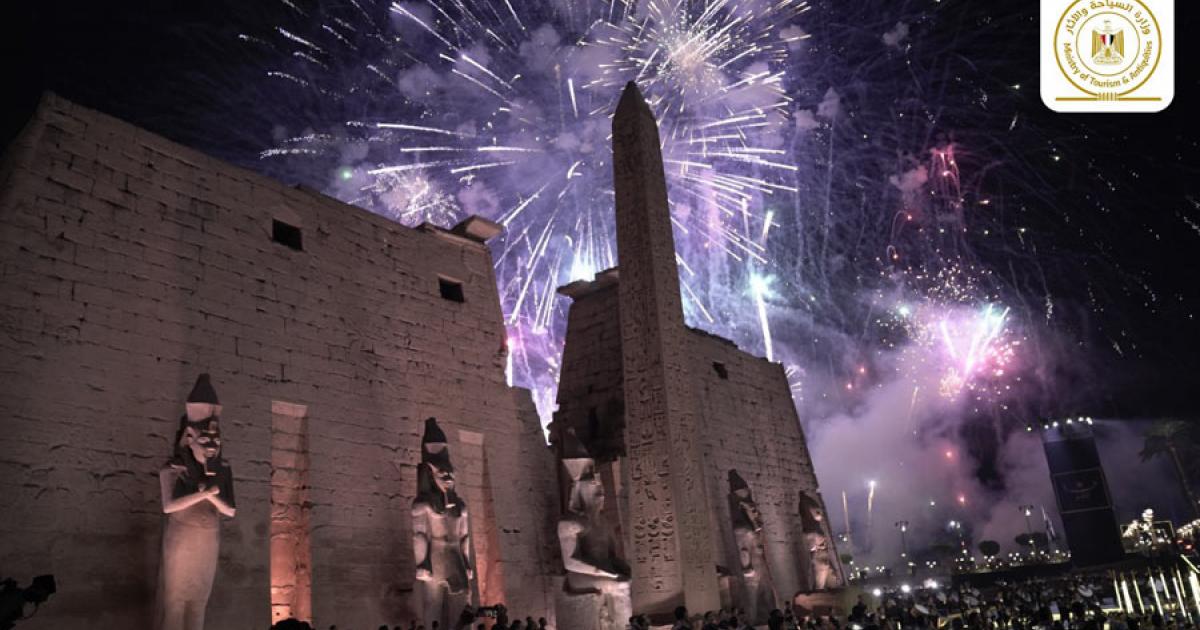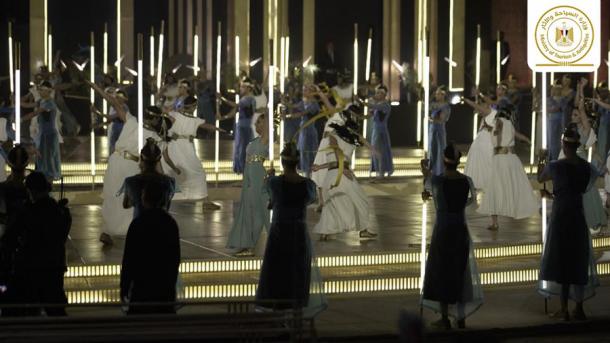
Opet Festival Extravaganza Marks Reopening of Avenue of Sphinxes
Egypt hosted the re-enactment of the ancient Egyptian Opet festival last night. The grand ceremony was held to mark the reopening of the 1.7-mile-long (2.7 km) road which links the Temples of Karnak in the north and Luxor in the south, once called the Path of God.
Paved in sandstone blocks, the 3,400-year-old road is lined on both sides with more than 1,050 statues of sphinxes and rams, which explains why it is also known as the Road of the Rams or the Avenue of the Sphinxes. The statues have been buried for centuries under the desert sand, but they have been slowly excavated ever since eight of them were first discovered outside Luxor Temple by archaeologist Mohammed Zakaria Ghoneim in 1949.
Dr. Mustafa Al-Saghir, Director General of the Karnak monuments, told CBS News that 309 statues in a good state of preservation have so far been uncovered but the number is likely to go up as excavations continue.

The lavish parade to mark the re-opening of the Avenue of Sphinxes and celebrate the Opet festival. (YouTube / Experience Egypt)
Understanding the Ancient Egyptian Opet Festival
The sacred avenue is believed to have been built to mark the Opet festival, an annual event at which the reigning pharaoh would undergo a ritual marriage ceremony with the deity Amun. Held annually in the second month of the Nile flooding season, the festival celebrated the fertility of the gods and the pharaohs.
- Luxor Temple: The Sacred Sanctuary With An Eternal Legacy
- Three Giant Criosphinxes Discovered On Egypt’s Cultic Avenue in Luxor
During the Opet Festival, the Theban deities Amun-Re, his consort Mut and their son Khonsu were transported from Karnak to Luxor in three divine boats carried by priests for the festival. The journey was made on foot along the Avenue of Sphinxes or sometimes by boat along the Nile River. It was in Luxor that the marriage ceremony was held. The reigning king decided on the length of the festival and at its close the deities were carried back to Karnak.

The ancient Egyptian Opet Festival was celebrated with music, dance, a dramatic parade and a great helping of Egyptian-style pomp. (Ministry of Tourism and Antiquities – Egypt)
“The Opet Festival will be held, as it was in the past at the time of the Pharaohs,” explained Ali Abu Dashish, archaeologist and member of the Egyptian Archaeological Union, according to news.com.au. The kick-off, on the 25th November 2021, featured a lavish parade with dancers in traditional dress, light displays, an orchestra, horse-drawn pharaonic chariots and boats on the Nile.
The Opet Festival celebrations were meant to send a message to the world that “we preserve and restore antiquities,” continued Abu Dashish. Reuters reported that President Abdel Fattah al-Sisi marched along the road at the opening of the ceremony.

The Opet Festival celebrations marked the opening of the Sphinx Avenue in Luxor, considered the largest open museum in the world. (Ministry of Tourism and Antiquities – Egypt)
But, When Was the Avenue of the Sphinxes Built?
While archaeologists are in unison over the purpose of the road, there is no agreement about who started the process of building it. According to some experts, it could have been Queen Hatshepsut about 3,500 years ago. But Dr. Al-Saghir has highlighted that researchers haven't found "any archaeological evidence on the road to back this theory.”
Others date the Avenue of the Sphinxes to King Amenhotep III who came to the throne a couple of hundred years after Queen Hatshepsut, in 1390 BC. However, Dr. Al-Saghir has also show skepticism of this theory, believing that some artifacts found on that road dating to that pharaoh’s reign were moved there later.
“The oldest monument we discovered of the road goes back to King Tutankhamun, who made the first 300 meters (984 ft) from the 10th pylon of the Karnak Temple to the gate of the Mut Temple,” explained Al-Saghir. This backs his belief that the road was conceived and launched by the famous King Tutankhamun around 3,000 years ago.

The Opet Festival celebration and parade along the Avenue of Sphinxes that runs between Karnack and Luxor. (Ministry of Tourism and Antiquities – Egypt)
Restoring the Avenue of the Sphinxes
While experts may not agree on who initiated the project, they mostly concur that the majority of it, a stretch of around 2,400 yards (2,194 m), was built under King Nectanebo I, the founder of the 30th and last native dynasty of Egypt, about 2,400 years ago.
- Four Ancient Egyptian Sphinxes Sacrificed In Political Chess Match
- Pharaoh’s Parade: Mummified Display of Egypt’s Glorious Past
The road has undergone several restoration efforts since being discovered in 1949, the latest of which began in 2017. As archaeologists have mapped the road, the restoration has entailed the demolition of some buildings that came up along the route once it was abandoned. These include mosques, houses and a church.
The grand parade and Opet festival celebrations were held to mark the reopening of the ancient road linking Karnak to Luxor, Egypt’s second most-visited tourist site after the Giza pyramids. They were also intended to promote Luxor as one of the largest open museums in the world.
Top image: Fireworks at the Opet festival at Luxor’s Sphinx Avenue opening. Source: Ministry of Tourism and Antiquities – Egypt
By Sahir Pandey















